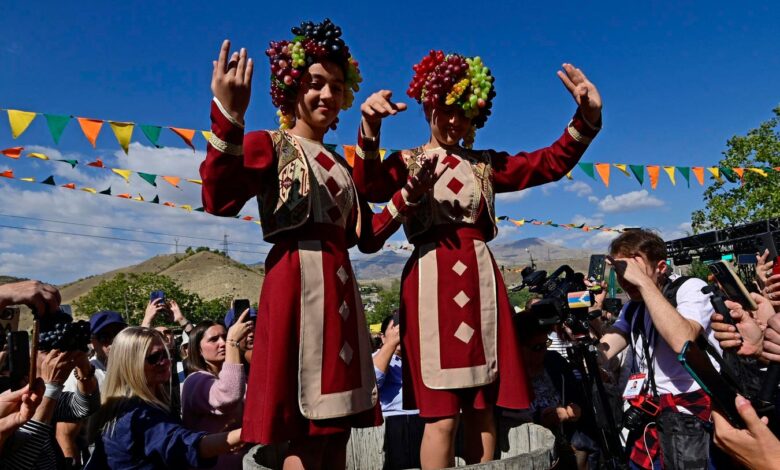Why Armenia’s Wine Story Takes The Crown In The ‘Birthplace’ Debate

📝 usncan Note: Why Armenia’s Wine Story Takes The Crown In The ‘Birthplace’ Debate
Disclaimer: This content has been prepared based on currently trending topics to increase your awareness.
Two barefoot girls wearing traditional costumes and headdresses made of grapes dance as they trample grapes to extract juice for fermentation during the annual wine festival in the village of Areni on October 5, 2024. (Photo by KAREN MINASYAN / AFP) (Photo by KAREN MINASYAN/AFP via Getty Images)
AFP via Getty Images
Armenia’s wine took a back seat to its brandy for most of the 20th century. Under Soviet rule, vineyards were redirected into industrial cognac production, creating a spirit so celebrated that, according to the International Churchill Society, “the prime minister developed a taste for the ArArAt brandy when it was served by Stalin at the Yalta conference in February 1945. After the Second World War, the Soviet leader arranged for Churchill to be sent 400 bottles every year.” The reputation stuck. Armenia was brandy country.
British Prime Minister Winston Churchill (1874 – 1965, left) clinks glasses with Soviet Ambassador Ivan Maisky (1884 – 1975) at a lunch party given by the ambassador for representatives of all the Allied governments, in the Winter Garden of the Soviet Embassy in London, August 1941. Original Publication : Picture Post – 864 – The Most Important Lunch Party Of The War – pub. 1941 (Photo by Picture Post/Hulton Archive/Getty Images)
Getty Images
But today, the country has a new moniker—the birthplace of wine.
Armenia And The World’s Oldest Winery
Areni, Armenia – August 3, 2024: way to Areni – 1 cave excavations complex, Armenia on summer day
getty
Along the Arpa River in Armenia’s Vayots Dzor province, it takes almost 100 stone steps to get to the opening of the Areni-1 Cave complex, a cool, echoing cavern perched on an old caravan route. In 2007, a UCLA-led team uncovered a shallow clay press draining into a fermentation vat, storage jars half-buried for temperature control, a cup and bowl and piles of grape skins, stems and seeds that tie the scene to wine. It is the earliest complete winemaking setup ever found.
Scientific testing places the discovery at around 4100 to 4000 B.C. “For the first time, we have a complete archaeological picture of wine production dating back 6,100 years,” said Gregory Areshian, co-director of the excavation and assistant director of UCLA’s Cotsen Institute of Archaeology, in an interview with National Geographic.
“People obviously were stomping the grapes with their feet, just the way it was done all over the Mediterranean and the way it was originally done in California.”
Ancient Storage Jar Found in Areni-1 Cave, World’s Earliest Known Winery in the Village of Areni, Archaeological site in Vayots Dzor Province of Armenia
getty
Chemists also found malvidin—the red pigment that makes wine stains stubborn—on shards of pottery and the vat interior. Multiple seeds were identified as vitis vinifera, the same species that produces fine wine today.
Inside the Areni-1 Cave, World’s Earliest Known Winery in the Village of Areni, Archaeological site in Vayots Dzor Province of Armenia
getty
There was another surprise—the world’s oldest leather shoe—a delightful collateral discovery that underscores the site’s time-capsule quality and why, like Rome, every shovel of soil here now demands forensic attention. The cave’s position on a historic east-west corridor hints at Armenian wine’s dual role from the start: both ritual and commerce.
The Bible And Armenia’s Wine History
Ancient Armenian church Khor Virap with Ararat on the background. The monastery was host to a theological seminary and was the residence of Armenian Catholicos.
getty
The winemaking apparatus was found next to what amounts to a cemetery, likely for sacramental or religious purposes. Scripture has long linked Armenia and wine—Noah’s ark landed on the “Mountains of Ararat,” overlooking the capital city of Yerevan, where Noah planted grape seeds. Throughout the Bronze Age and medieval centuries, Armenian vineyards thrived under the rule of kingdoms and monasteries.
Mark of Noah’s Ark in Dogubayazit, Turkey
getty
By the 5th century, Armenia had adopted Christianity as its state religion, and monastic winemaking became a cornerstone of its culture and economy. Caravans carried amphorae and wineskins along the Silk Road, where Armenian merchants were renowned for cultivating and blending wines.
The Caucasus, Caucasia, colored political map. Region between the Black Sea and the Caspian Sea, mainly occupied by Armenia, Azerbaijan, Georgia, and parts of Southern Russia. Map with disputed areas.
getty
Soviet Rule Changed Armenia’s Wine Industry
The 20th century nearly severed that lineage when, under Soviet rule from 1920 to 1991, wine production shifted to brandy production—but luckily, some native grapes survived in family plots where they were grown for household wine.
When Armenia regained independence in 1991, a new generation of winemakers began reclaiming those native grapes—Areni, Armenia’s flagship red, often compared to pinot noir for its finesse; Voskehat, known as “golden berry,” a white variety prized for floral aromatics and mineral backbone; and Khatouni, a white grape offering delicate texture and subtle stone fruit notes. They also began reintroducing ancient methods, like karas winemaking—fermenting and aging in buried clay.
Armenia’s Wine Makers
Glass of red wine at the Areni Wine Factory in Armenia
getty
The comeback is now visible throughout the country. Trinity Canyon Vineyards, a short drive from Areni-1, leans into terracotta vessels and indigenous fruit, effectively pouring the archaeology forward. Producers such as Zorah Wines age Areni in traditional karas, earning international acclaim.
Mariam Saghatelyan co-founded the country’s first wine bar, InVino, in 2012. By pairing tastings with tours and classes, Saghatelyan has helped shift local perceptions of wine from a niche import to a cultural revival. She also teaches wine business there, passing along tools to build Armenia’s next generation of winemakers and entrepreneurs.
If Saghatelyan built Armenia’s wine culture from the ground up in Yerevan, Gevorkian Winery has been pushing the boundaries of what Armenian wine can be in the cellar. Known for experimenting with both tradition and innovation, Gevorkian produced the country’s first pétillant naturel (pét-nat), added pomegranate wine to the portfolio and revived kakhani—an ancient method of sun-drying grapes for late-harvest styles.
Krya, meanwhile, has taken a different tack: going backward in order to go forward. The winery is restoring neglected old vines in Vayots Dzor, elevating heritage fruit into terroir-driven bottlings. Its work has given voice to vineyards that might otherwise have vanished, and it represents the preservationist wing of Armenia’s comeback story.
The past may have given Armenia a headline, but these players are making sure the future has a marketplace. Wine exports have more than doubled in the past decade, according to the U.S. International Trade Administration, with bottles now reaching more than 30 countries.
And international attention is validating Armenia’s comeback. The California winemaker Paul Hobbs visited Armenia in 2005—two years before the Areni-1 discovery—and quickly recognized its potential. He teamed up with Viken Yacoubian to found Yacoubian-Hobbs near the Areni-1 cave. Unlike many wine producers in Armenia, its wines can be purchased online in the U.S., giving consumers a direct taste of the world’s oldest wine story.
Vineyards in Armenia
getty
What makes Armenia’s claim to fame distinctive is its reliance on archaeology as much as viticulture. Unlike its neighbors, Georgia and Turkey, Armenia can point to a single excavated site with a press, a vat and grape DNA, neatly tying the past to the present.
The fact that the grape seeds belong to Areni, which is still cultivated in Armenia today, lends the claim unusual continuity. Its position on one of the region’s most important trade routes cements Armenia as both an origin point of winemaking and a gateway to its spread across Europe and Asia.
Close up small wine grapes on trees on vineyard field on autumn in Armenia with famous landmark of Khor Virap monastery. Harvesting season in caucasus. Wine produce Armenia
getty
From Armenia’s Wine To Brandy And Back
Armenia will always be proud of the brandy that once charmed Churchill. But its wine story—anchored in a cave older than the pyramids—is what it wants the world to remember now. With indigenous grapes back in the spotlight, clay jars are being dug again, and bottles are appearing on shelves from Paris to Los Angeles. Armenia’s wine industry is no longer hidden in home plots or rediscovering its roots. It’s rewriting its future.



